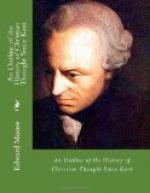STRAUSS
On the other hand, as Pfleiderer has said, we must remember the difficulty which beset the men of that age. Their general culture made it difficult for them to accept the miraculous element in the gospel narrative as it stood. Yet their theory of Scripture gave them no notion as to any other way in which the narratives might be understood. The men had never asked themselves how the narratives arose. In the preface to his Leben Jesu, Strauss said: ’Orthodox and rationalists alike proceed from the false assumption that we have always in the Gospels testimony, sometimes even that of eye-witnesses, to fact. They are, therefore, reduced to asking themselves what can have been the real and natural fact which is here witnessed to in such extraordinary way. We have to realise,’ Strauss proceeds, ’that the narrators testify sometimes, not to outward facts, but to ideas, often most poetical and beautiful ideas, constructions which even eye-witnesses had unconsciously put upon facts, imagination concerning them, reflexions upon them, reflexions and imaginings such as were natural to the time and at the author’s level of culture. What we have here is not falsehood, not misrepresentation of the truth. It is a plastic, naive, and, at the same time, often most profound apprehension of truth, within the area of religious feeling and poetic insight. It results in narrative, legendary, mythical in nature, illustrative often of spiritual truth in a manner more perfect than any hard, prosaic statement could achieve.’ Before Strauss men had appreciated that particular episodes, like the virgin birth and the bodily resurrection, might have some such explanation as this. No one had ever undertaken to apply this method consistently, from one end to the other of the gospel narrative. What was of more significance, no one had clearly defined the conception of legend. Strauss was sure that in the application of this notion to certain portions




